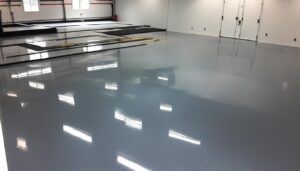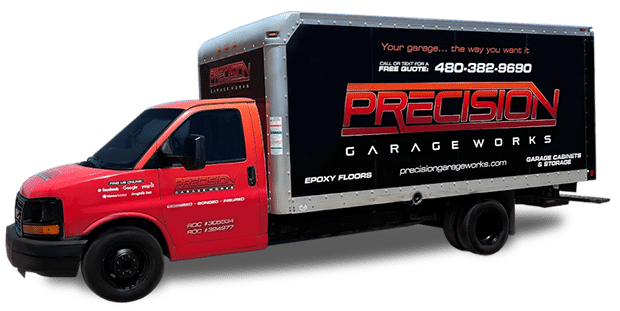Polyurea floors are a popular choice for their durability and longevity, but have you ever wondered just how long they can last? Well, here’s a surprising fact: polyurea floors can have a lifespan of up to 20 years with proper care and maintenance. That’s two decades of reliable and visually appealing flooring!
Understanding the lifespan of polyurea floors is crucial for anyone considering this flooring option. Whether you’re looking to install polyurea floors in a commercial space, an industrial facility, or even your garage, knowing how long they can last will help you make an informed decision and ensure that your investment stands the test of time.
Key Takeaways:
- Polyurea floors can last up to 20 years with proper care and maintenance.
- Knowing the lifespan of polyurea floors is essential for making informed flooring decisions.
- Polyurea floors are a reliable and visually appealing flooring option for various environments.
- Proper care and maintenance are key to extending the lifespan of polyurea floors.
- Regular inspections and prompt repairs can help prevent further damage and maintain the quality of polyurea floors.
The Durability of Polyurea Flooring
Polyurea flooring is known for its exceptional durability. It is highly resistant to impacts, abrasions, and chemicals, making it suitable for a wide range of applications. Whether it’s a high-traffic commercial space, an industrial facility, or a garage, polyurea flooring offers reliable protection against wear and tear.
The durability of polyurea flooring stems from its unique composition and seamless installation process. Unlike traditional flooring options, polyurea forms a strong, continuous surface that is resistant to cracks and chips. This seamless nature not only enhances the appearance of the floor but also reinforces its strength and longevity.
One of the key features of polyurea flooring is its resistance to impacts. Whether it’s heavy equipment, constant foot traffic, or the occasional dropped object, polyurea can withstand the daily challenges faced in various environments. This impact resistance ensures that the floor maintains its integrity and quality, even under demanding conditions.
In addition to impact resistance, polyurea flooring is highly resistant to chemicals. It can withstand exposure to a wide range of substances without undergoing damage or discoloration. This chemical resistance makes it an excellent choice for areas where spills or leaks may occur, such as laboratories, warehouses, or manufacturing facilities.
Furthermore, polyurea flooring is highly resistant to abrasions. The strong and resilient surface can withstand the friction caused by heavy machinery, vehicle traffic, and constant movement without degrading or losing its aesthetic appeal. This resistance to abrasions ensures that the floor maintains its smooth and attractive finish for years to come.
Overall, polyurea flooring offers unparalleled durability, making it a cost-effective and reliable choice for any space that requires long-lasting flooring solutions. Its resistance to impacts, chemicals, and abrasions ensures that polyurea floors can withstand the test of time, providing a high-quality and visually appealing flooring option that stands up to daily wear and tear.
Factors Influencing the Lifespan of Polyurea Floors
Several factors can influence the lifespan of polyurea floors. These factors include the quality of the installation, foot traffic, and the maintenance routine. By considering and addressing these factors, property owners can ensure that their polyurea floors remain in excellent condition for an extended period.
First and foremost, the quality of the installation is a critical factor in determining the lifespan of polyurea floors. An expertly installed floor will have a smoother and more even surface, reducing the likelihood of issues arising in the future. Hiring a professional with experience in installing polyurea floors is essential to ensure a high-quality installation that can withstand the test of time.
Secondly, the amount of foot traffic that a polyurea floor experiences can significantly impact its longevity. High-traffic areas, such as commercial spaces or industrial facilities, may require more frequent maintenance and recoating to maintain the floor’s integrity. Regular inspections and prompt repairs of any signs of wear are vital to prevent further damage and maintain the durability of the floor.
Lastly, establishing a proper maintenance routine is crucial for extending the lifespan of polyurea floors. Regular cleaning using non-abrasive solutions helps keep the floor free from dirt, debris, and potential stains. It is important to promptly address any spills to prevent long-term damage. Additionally, applying protective coatings periodically can provide an extra layer of defense against wear and tear, further enhancing the floor’s durability.
Integrating these factors into the design, installation, and maintenance of polyurea floors can significantly contribute to their longevity. By addressing installation quality, foot traffic, and maintenance routine, property owners can ensure that their polyurea floors remain in optimal condition, providing a durable and visually appealing flooring solution for years to come.
The Average Lifespan of Polyurea Floor Coatings
On average, polyurea floor coatings can last anywhere from 15 to 20 years with proper care and maintenance. These coatings are specifically designed to be durable and resistant to various forms of wear, making them an excellent choice for high-traffic areas.
Proper care and maintenance are crucial for maximizing the lifespan of polyurea floor coatings. This includes regular inspections to identify any signs of wear or damage. By addressing these issues promptly, you can prevent further deterioration and extend the life of the floor coatings.
Regular maintenance activities, such as cleaning and applying protective coatings, can also help prolong the lifespan of polyurea floor coatings. Cleaning the floor regularly with non-abrasive solutions helps remove dirt and debris that can contribute to premature wear. Additionally, applying a protective coating periodically provides an extra layer of defense against scratches, stains, and other forms of damage.
It’s important to note that while the average lifespan of polyurea floor coatings is 15 to 20 years, individual circumstances can impact the actual longevity of the coatings. Factors such as the level of foot traffic, the quality of the installation, and the maintenance routine can all play a role in determining how long the floor coatings will last.
Installation Process and Its Impact on Longevity
The installation process has a significant impact on the longevity of polyurea floors. To ensure a seamless and durable floor, it is crucial to hire experienced professionals who follow proper installation techniques. By entrusting the installation to experts, both the immediate and long-term quality of the floor can be assured.
Proper surface preparation is a crucial step in the installation process. Thoroughly cleaning the surface and repairing any existing damage creates a solid foundation for the polyurea floor coating. Addressing any cracks, unevenness, or imperfections before the installation significantly contributes to its longevity.
During the installation process, the polyurea material is applied to the prepared surface. This material quickly cures and creates a strongly bonded, continuous coating. The seamless nature of the polyurea floor provides added strength, minimizing the risk of cracks, chips, or other damage that can compromise its longevity.
Additionally, experienced installers ensure that the polyurea coating is evenly applied, avoiding bubbles or inconsistencies that can weaken the floor over time. Attention to detail during the installation process is essential for achieving a high-quality, durable polyurea floor.
Maintenance Tips for Extending the Life of Polyurea Floors
Proper maintenance is key to extending the life of polyurea floors. By following a few essential tips, you can keep your polyurea floors looking great and ensure their longevity.
1. Regular Cleaning: Regular cleaning with non-abrasive solutions is crucial for keeping polyurea floors free from dirt and debris. Use a mild cleaner or a mixture of warm water and a pH-neutral floor cleaner. Avoid using harsh chemicals or abrasive cleaners that can damage the floor’s protective coating.
2. Promptly Clean Up Spills: It is essential to promptly clean up any spills on polyurea floors to prevent staining or damage. Use a soft cloth or mop to absorb the spill, then clean the area with a mild cleaner. Avoid letting liquids sit on the floor for an extended period.
3. Use Floor Mats: Placing floor mats at entrances can help prevent dirt, grit, and moisture from being tracked onto the polyurea floor. This protects the surface from scratching and reduces the risk of slips or falls. Ensure that the mats are cleaned or replaced regularly to avoid dirt build-up.
4. Apply Protective Coatings: Periodically applying protective coatings can provide an extra layer of defense against wear and tear. Consult with a professional flooring contractor to determine the appropriate coating products and application schedule for your polyurea floors. These protective coatings help maintain the floor’s glossy appearance and enhance its durability.
Common Signs of Wear and How to Address Them
Over time, polyurea floors may show signs of wear. These signs can include cracks, chips, or discoloration. It is crucial to address these issues promptly to prevent further damage.
- Cracks: Minor cracks can be repaired using polyurea fillers or sealants. These products are specifically designed to bond with the existing floor and restore its structural integrity. Applying the filler or sealant to the cracked area and allowing it to cure will effectively seal the crack and prevent it from spreading.
- Chips: If you notice any chipped areas on your polyurea floor, it is important to repair them to maintain the floor’s appearance and prevent further damage. Start by cleaning the chipped area thoroughly to remove any dirt or debris. Then, apply a polyurea patching compound to fill the chip and smooth the surface. After the compound has cured, you can lightly sand the area to ensure a seamless blend with the surrounding floor.
- Discoloration: Discoloration on polyurea floors can be caused by various factors, such as exposure to sunlight, chemical spills, or improper cleaning techniques. To address discoloration, begin by identifying the cause. If the discoloration is due to sunlight exposure, consider installing UV-protective coatings or using window treatments to minimize the impact. For chemical spills, it is important to clean them up immediately and use appropriate cleaning agents recommended for polyurea floors. If the discoloration persists, it may be necessary to recoat the entire floor to restore its uniform appearance.
Regular inspections and maintenance can help identify these signs of wear early and take appropriate action. By addressing signs of wear promptly, you can maintain the longevity and aesthetic appeal of your polyurea floor.
Conclusion
Summing up, polyurea floors are a long-lasting and durable flooring option that can withstand heavy use and various environmental conditions. When installed properly and maintained regularly, polyurea floors can provide an aesthetically pleasing and high-quality flooring solution for many years to come.
The inherent strength and resistance of polyurea flooring make it an excellent choice for commercial and industrial applications. Its durability allows it to withstand impacts, abrasions, and chemical exposure, making it highly suitable for high-traffic areas.
To ensure the longevity of polyurea floors, it is crucial to follow a consistent maintenance routine. Regular cleaning with non-abrasive solutions, prompt handling of spills, and the use of floor mats for extra protection can prevent premature wear and maintain the floor’s integrity.
By addressing any signs of wear promptly, such as cracks or discoloration, and taking appropriate action, such as repairing or recoating the floor, the lifespan of polyurea floors can be extended. With proper installation and ongoing maintenance, polyurea flooring can continue to provide a durable, visually appealing, and long-lasting flooring solution.



